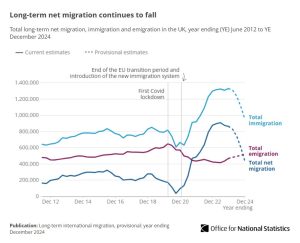50% Fall in Net UK Migration in 2024
Driven by Visa Changes and Student Departures
Summary
- Net migration to the UK dropped to 431,000 in 2024, down from 860,000 in 2023 — a 49.9% decrease.
- The fall reflects fewer arrivals on work and study visas, and more students leaving after graduation.
- Visa restrictions by the former Conservative government contributed to a sharp drop in immigration.
- Public reaction is mixed, with some welcoming the fall, while others say it’s still too high.
United Kingdom — Net Migration to UK Halves in 2024 Amid Visa Clampdowns and Student Exodus
Net migration to the UK dropped significantly in 2024, falling to 431,000 from a revised record high of 860,000 in 2023 — a 49.9% decline, according to figures released by the Office for National Statistics (ONS). This marks the largest calendar-year fall since the early COVID-19 pandemic and puts net migration below one million for the first time in three years.
The decline was largely driven by policy changes introduced by the Conservative government in early 2024, including a ban on most international students (except PhD candidates) bringing dependants, stricter rules on care worker visas, and a sharp increase in the salary threshold for skilled workers. These measures led to significant drops in visa grants: student dependant visa applications fell by 84%, while Health and Care Worker visas dropped 81%.

Emigration also rose, particularly among non-EU students who arrived during the post-pandemic period and completed their studies. Despite 198,000 Graduate visas being issued in the year to June 2024, many international students chose to leave. In total, about 956,000 people immigrated to the UK in 2024, while 525,000 left.
Non-EU nationals continued to dominate migration figures, making up 86% of long-term arrivals. Key countries of origin included India, Nigeria, Pakistan, China, and Zimbabwe, with work and study remaining the top reasons for migration.
Although the 2024 figure is well below the peak of 906,000 recorded in the year to June 2023, it remains significantly higher than pre-Brexit averages of around 250,000, prompting mixed public responses.
Posts on social media platform X reflect both relief at the reduction and frustration that net migration is still above earlier government promises of bringing it down to the “tens of thousands.”
The new Labour government, elected in July 2024, has pledged further migration reductions. Prime Minister Keir Starmer has promised new policies to reduce reliance on foreign workers, especially in the health and social care sectors. However, these proposals are not yet reflected in the 2024 data.
The ONS cautioned that its figures are provisional and subject to revision, as seen with previous years. Net migration for 2023 was initially reported at 685,000 but later revised up to 860,000. Migration experts expect net migration may continue to fall, potentially reaching 340,000 by 2028, depending on future policy and global developments.
For now, the drop marks a turning point in the UK’s post-Brexit migration landscape — but whether it reflects a sustained trend or a short-term shift remains to be seen.







